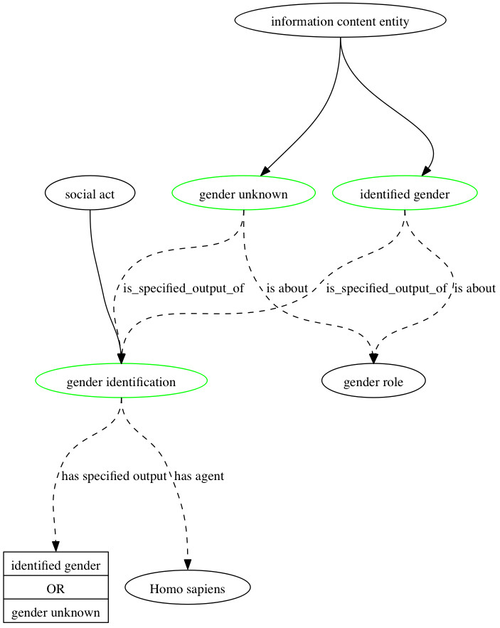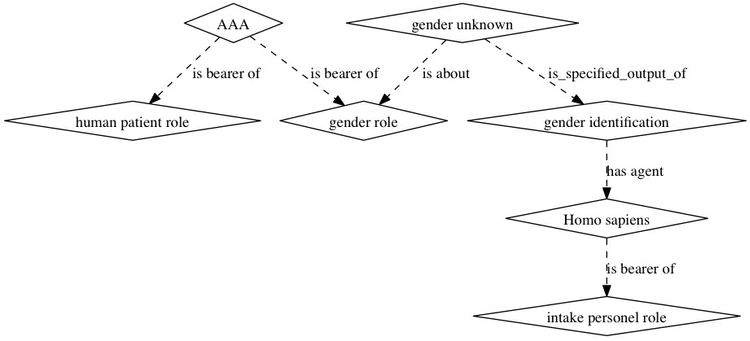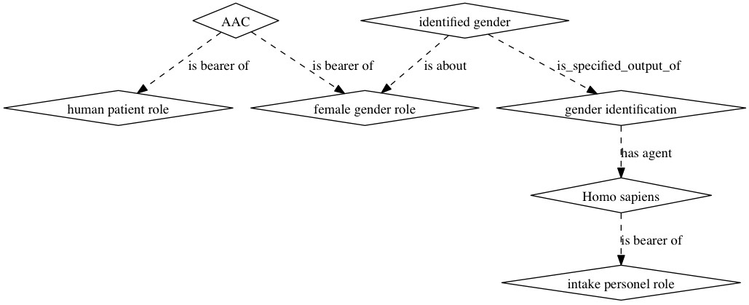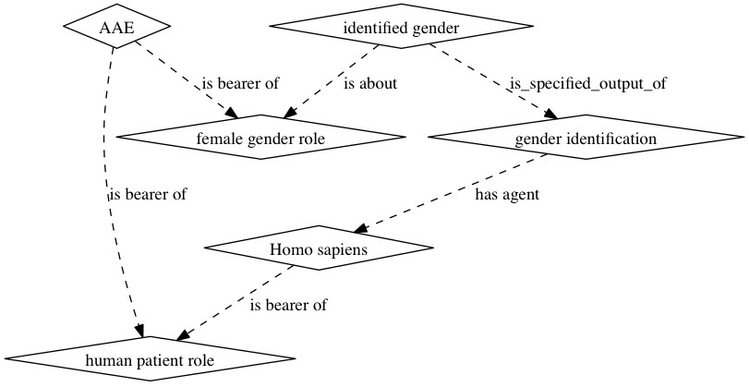OMRSE - Who Identified the Gender of a Patient?
This page discusses questions related to how we can best model who identified the gender of a patient.
The question is, how do we model at the conceptual level a situation in which the patient identified themselves? Prior to that, perhaps we ought to ask, do we need to model this at the conceptual level, or will this be taken care of as a matter of course at the instance level?
Proposed Classes
Gender Identification
Definition:
Gender identification is a social act that results in a documentation of what is known about person’s gender. The specified output of a gender identification can be an “identified gender” data item or a “gender unknown” data item.
Ontological representation:
SubClass:
- ‘social act’
- (has_specified_output some
('identified gender’ or 'gender unknown')) - ‘has agent’ some ('Homo sapiens'
and ‘is bearer of’ some role)
Comments:
- "'is bearer of' some role" was determined to be too general to be useful for this definition.
- The natural language definition was changed to avoid suggesting that a mere verbal statement that is not recorded could be considered a gender identification. Gender identifications have ICEs as specified output.
- We decided to not make this a subclass of "documenting" since that would require the input to be an information content entity.
- There was some question regarding whether "gender identification" is properly a subclass of "social act". For now, we continue to model them as social acts. I (Amanda) will revisit the Identity Documents paper to in light of the question of whether they are 'social acts'.
Gender Unknown
Definition:
Gender unknown is a data item that is the specified output of an act of gender identification and indicates that the person performing the gender identification does not know the gender of a particular person. Notice that gender unknown is not a type of gender, but is an information content entity (ICE).
Ontological representation:
Subclass:
‘data item’'information content entity'- ‘is about’ some ‘gender role’
- is_specified_output_of some ‘gender identification’
Comments:
- Is this use of ‘is about’ correct?
- We decided to represent "gender unknown" and "identified gender" as "information content entities" instead of "data items" since it is not always and uncontroversially the case that answering questions in an identification process is a "method which reliably tends to produce (approximately) truthful statements." per the definition of "data item".
Identified Gender
Documented Gender Identity
Definition:
Documented gender identity is an information content entity that is the specified outcome of an act of gender identification and indicates that a particular person is the bearer of a particular type of gender role. Notice that identified gender is not a type of gender, but is an ICE.
Ontological representation:
Subclass:
‘data item’'information content entity'- ‘is about’ some ‘gender role’
- ‘is_specified_output_of’ some ‘gender identification’
Comments:
- Below is a graph of this representation. The green nodes are the proposed classes.
- This graph has been updated in light of discussion during the meeting on July 15, 2014.
Examples with individuals
AAA is a patient, and intake personnel marked gender as “unknown.”
Type:
- 'is bearer of' some
('gender role'
and ( inverse ('is about') some
('gender unknown'
and (is_specified_output_of some
('gender identification'
and (has_agent some ('is bearer of' some 'intake personnel role')))))))
- ‘is bearer of’ some ‘human patient role’
Below is an image of how this is modeled at the instance level. The diamond-shaped nodes represent instances, not classes.
AAB is a patient, and the nurse documented the patient's gender as unknown.
Type:
- 'is bearer of' some
('gender role'
and ( inverse ('is about') some
('gender unknown'
and (is_specified_output_of some
('gender identification'
and (has_agent some ('is bearer of' some 'nurse role')))))))
- 'is bearer of' some 'human patient role'
AAC is a patient and was identified as female by intake personnel
Type:
- 'is bearer of' some
('female gender role'
and ( inverse ('is about') some
('identified gender'
and (is_specified_output_of some
('gender identification'
and (has_agent some ('is bearer of' some 'intake personnel role')))))))
- ‘is bearer of’ some ‘human patient role’
AAE is a patient and self-identified as female.
Type:
- 'is bearer of' some
('female gender role'
and ( inverse ('is about') some
('identified gender'
and (is_specified_output_of some
('gender identification'
and (has_agent some 'is bearer of' some ‘human patient role’))))))
- ‘is bearer of’ some ‘human patient role’
Comment:
Notice that this restriction does not rule out the possibility that AAE’s gender was identified by another patient. The above image is misleading in the respect. In the ontology we cannot state that the human patient role that inheres in AAE is identical with the human patient role involved in the act of gender identification.
Question:
Does this matter? In a database will there simply be an identifier for the person who identified the gender of a patient? If so, do we need to worry about stating that AAE’s gender was identified AND that AAE did the identifying? Can we query for patients who have self-identified their own gender?
Answer:
We determined that self-identification does not need to be represented at the general level since queries can be constructed that specify that the bearer of a gender role and the agent of a gender identification process should be identical and sense OWL does not support class restrictions that utilize identity (in the mathematical logical sense of '=') between individuals.



